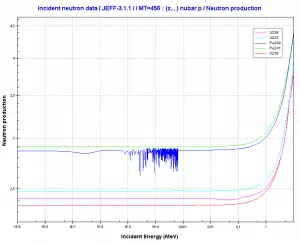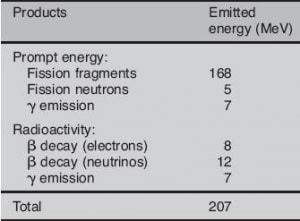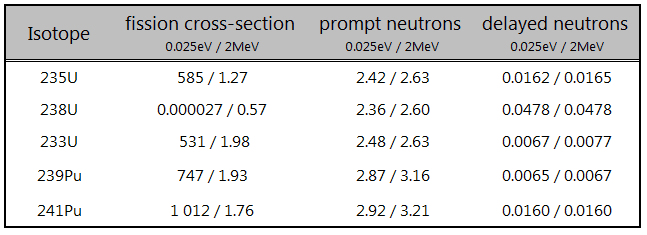It is known the fission neutrons are of importance in any chain-reacting system. Neutrons trigger the nuclear fission of some nuclei (235U, 238U, or even 232Th). What is crucial the fission of such nuclei produces 2, 3, or more free neutrons.
But not all neutrons are released at the same time following fission. Even the nature of the creation of these neutrons is different. From this point of view, we usually divide the fission neutrons into two following groups:
- Prompt Neutrons. Prompt neutrons are emitted directly from fission, and they are emitted within a very short time of about 10-14 seconds.
- Delayed Neutrons. Delayed neutrons are emitted by neutron-rich fission fragments that are called delayed neutron precursors. These precursors usually undergo beta decay, but a small fraction of them are excited enough to undergo neutron emission. The neutron is produced via this type of decay, and this happens orders of magnitude later than the emission of the prompt neutrons, which plays an extremely important role in the control of the reactor.


Key Characteristics of Prompt Neutrons
- Prompt neutrons are emitted directly from fission, and they are emitted within a very short time of about 10-14 seconds.
- Most of the neutrons produced in fission are prompt neutrons – about 99.9%.
- For example, fission of 235U by thermal neutron yields 2.43 neutrons, of which 2.42 neutrons are prompt neutrons, and 0.01585 neutrons are the delayed neutrons.
- The production of prompt neutrons slightly increases with incident neutron energy.
- Almost all prompt fission neutrons have energies between 0.1 MeV and 10 MeV.
- The mean neutron energy is about 2 MeV. The most probable neutron energy is about 0.7 MeV.
- In reactor design, the prompt neutron lifetime (PNL) belongs to key neutron-physical characteristics of the reactor core.
- Its value depends especially on the type of the moderator and the energy of the neutrons causing fission.
- In an infinite reactor (without escape), prompt neutron lifetime is the sum of the slowing downtime and the diffusion time.
- In LWRs, the PNL increases with the fuel burnup.
- The typical prompt neutron lifetime in thermal reactors is on the order of 10-4 seconds.
- The typical prompt neutron lifetime in fast reactors is on the order of 10-7 seconds.
Key Characteristics of Delayed Neutrons
- The presence of delayed neutrons is perhaps the most important aspect of the fission process from the viewpoint of reactor control.
- Delayed neutrons are emitted by neutron-rich fission fragments that are called delayed neutron precursors.
- These precursors usually undergo beta decay, but a small fraction of them are excited enough to undergo neutron emission.
- The emission of neutrons happens orders of magnitude later compared to the emission of the prompt neutrons.
- About 240 n-emitters are known between 8He and 210Tl. About 75 of them are in the non-fission region.
- It is suggested to group together the precursors based on their half-lives to simplify reactor kinetic calculations.
- Therefore delayed six delayed neutron groups traditionally represent neutrons.
- Neutrons can also be produced in (γ, n) reactions (especially in reactors with heavy water moderator), and therefore, they are usually referred to as photoneutrons. Photoneutrons are usually treated no differently than regularly delayed neutrons in the kinetic calculations.
- The total yield of delayed neutrons per fission, vd, depends on:
- An isotope that is fissioned.
- The energy of a neutron induces fission.
- Variation among individual group yields is much greater than variation among group periods.
- In reactor kinetic calculations, it is convenient to use relative units as delayed neutron fraction (DNF).
- At the steady-state condition of criticality, with keff = 1, the delayed neutron fraction is equal to the precursor yield fraction β.
- In LWRs, the β decreases with fuel burnup. This is due to isotopic changes in the fuel.
- Delayed neutrons have initial energy between 0.3 and 0.9 MeV with an average energy of 0.4 MeV.
- Depending on the type of the reactor, and their spectrum, the delayed neutrons may be more (in thermal reactors) or less effective than prompt neutrons (in fast reactors). The effectively delayed neutron fraction – βeff must be defined to include this effect in the reactor kinetic calculations.
- The effectively delayed neutron fraction is the product of the average delayed neutron fraction and the importance factor βeff = β . I.
- The weighted delayed generation time is given by τ = ∑iτi . βi / β = 13.05 s, therefore the weighted decay constant λ = 1 / τ ≈ 0.08 s-1.
- The mean generation time with delayed neutrons is about ~0.1 s, rather than ~10-5 as in section Prompt Neutron Lifetime, where the delayed neutrons were omitted.
- Their presence completely changes the dynamic time response to some reactivity change, making it controllable by control systems such as the control rods.
